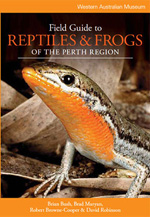
A burrowing snake-like worm lizard (Aprasia repens)

Although lizards and snakes display many distinctive characteristics it is generally believed that snakes evolved from a lizard-like ancestor. Possibly a primitive lizard similar in many ways to the monitor lizards of today. Maybe the snakes' limbed ancestors increasingly moved to a poorly utilised and therefore less competitive subterranean environment. Large limbs and thick bodies would hinder movement through soil. To be successful a more elongate form without protruding limbs was needed. Hence today's snakes.
This progression to a slender form and limblessness can be seen in some lizard groups today. Members of the genus Lerista display varying degrees of elongation and a reduction in both the size and number of limbs. Those species that forage mostly on the surface have comparatively thick bodies and well developed limbs whilst those that appear to spend most of their life burrowing through loose soils are long, slender and limbless.
Legless lizards of the family Pygopodidae (see photo of worm lizard, Aprasia inaurita above) display similar trends but all members lack fully developed limbs. The worm lizards (Aprasia) are burrowers with only a trace of hindlimbs in the form of scaly flaps, one on each side, and lack external ear openings. Members of the genus Delma spend little time below ground and have a larger hindlimb flap and obvious ear opening. The Pygopus species have the largest hindlimb flaps and ear openings and are successful above ground and semi-arboreal foragers. The Pygopodidae includes 2 exceptional species having unusual characteristics that do not fit the trend (see Aclys and Pletholax genera).
In the Perth region we experience a temperate Mediterranean climate with cool winters. Many of our local reptiles enter a period of torpor or inactivity during the cool months. Some species appear less cold effected than others. The Tiger Snake is cold tolerant while the Dugite is not, therefore you may see a tiger snake basking on a sunny winters' day but never a Dugite. A reptile will seek out its winter retreat with the onset of cold weather. These may be the disused burrows of other animals, nooks and crannies in and amongst root systems, beneath rocks and logs or any place where the temperature will not fall to zero. When the temperature rises in spring activity will recommence.
The sense of smell is well developed in most reptiles but particularly so in snakes and those lizards with a forked tongue. A paired sensory organ is located in the roof of the mouth. It consists of 2 highly odour-sensitive pits that analyse particles conveyed to it on the forked end of the tongue. The constant flicking of the tongue is a notable feature of snakes and some lizards, particularly monitor lizards. They are testing the air to determine whether there is food, a threat, or a mate nearby.
The hearing in snakes and some lizards is not as we understand it. They do not have an external ear opening. They are not deaf, just lack the ability to detect high frequencies of sound conveyed through the air. They do hear or more correctly feel low frequencies, and have a tremendous ability to detect the most subtle of vibrations transmitted through sand, leaflitter, dried grasses and to a lesser degree hard ground.
The eyesight in lizards and snakes is good, especially in seeing movement. Anyone observing a lizard catching insects or a snake's response to any movement up to a distances of 30 metres will appreciate the acuteness of this. One has to be careful feeding captive snakes for they will respond to their own reflection in the keeper's eyes. The whip snakes (genus Demansia) are generally lizard feeders that catch their prey on the run. The eyesight must be good to maintain visual contact with the darting and dodging lizard. The ability of snakes and even some lizards to locate stationary objects with the eyes is indeed poor, but any disadvantage is offset by the acute nature of the other senses.
All reptiles have dry skin, not wet and slimy as many people believe. The outer layer is dead and formed in numerous side-by-side or overlapping scales. Unlike in fish where the scales are attached to the skin, in reptiles the scales are the skin. As the outer layer is dead it will not grow with the animal and must be shed or sloughed (pronounced sluffed) off. In lizards with legs this is shed in pieces but in the snakes and legless lizards it usually comes off in one piece. They crawl out of the old skin turning it inside out as they go. Juveniles may slough as frequently as every 3 weeks while old reptiles may only do this 1-3 times a year. A physical feature that most sets the squamates apart from the other reptile groups is the fact that the males have paired sex organs. These are called hemipenes and are located internally at the base of the tail and are used independently.
Ear drums and external ear openings are present in most lizards but absent in snakes. The lower jaw is one piece in lizards whereas in typical snakes it is in two halves, divided medially. No Australian snake has the ability to regrow lost or damaged tails whereas many lizards can do this. Snakes generally have short tails rarely amounting to 20% of the total length whereas in lizards long tails are common. Snakes and legless lizards have internal organs that are modified to fit into a long slender body cavity. The left lung has reduced in size to the stage where it is almost nonexistent in some snakes while the right has lengthened. The liver and kidneys are cigar-shaped, the latter are also staggered with one located further along the body cavity.
